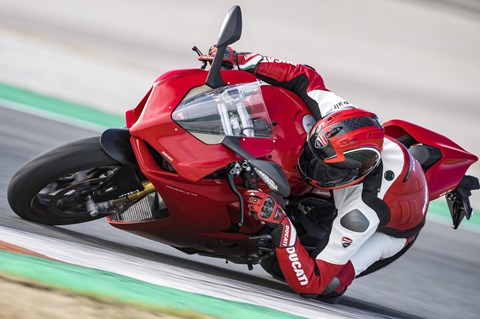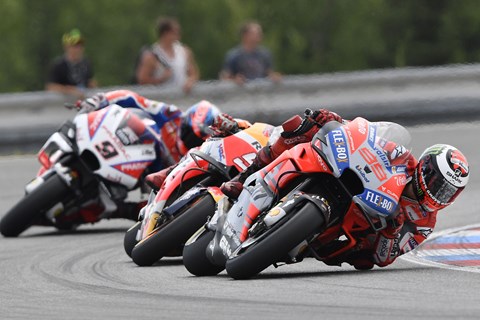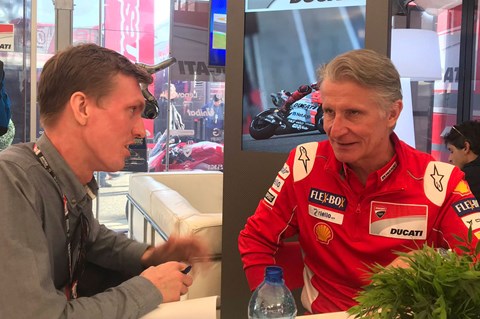► CAR chats to Ducati’s sporting director
► Paolo Ciabatti on intricacies of MotoGP
► ‘It’s a never-ending process; nobody stops’
CAR sat down with Ducati’s MotoGP sporting director, Paulo Ciabatti, at the rain-stricken British MotoGP round at Silverstone to chat about the complexities of running a front-running MotoGP team.
Here are some of Ciabatti’s thoughts on how David-sized Ducati takes on Goliath manufacturers with innovative tech, why MotoGP is a better show than F1, and how to transport an entire race team to 15 countries in one season without a hitch.
1) Think differently
‘If you want to fight with bigger manufacturers using the same philosophy you will probably not succeed. We need to think in a different way. We always search for novel solutions within the regulations. This is also good for the company as a whole, because most solutions can be brought into production bikes sooner or later. You must have an open mind.’
‘We are quite proud of what we have achieved so far, because we are a small company [compared with rival MotoGP manufacturers]. Of course, it is a never-ending process. Nobody stops and waits…’

2) Don’t go racing just to collect trophies
‘It wouldn’t be healthy for the company to race for the sake of winning races full-stop. Good for image, maybe, but it has to feed technology back to future products. Traction control, launch control, the V4 engine in the Panigale road bike – they all came from MotoGP.’
‘For example, aerodynamics – we were the first manufacturer to introduce winglets in 2015. Back then other teams were laughing at us – they thought it was just for attracting attention.’ [Now practically every bike in the pitlane is sprouting aerofoils – they’ll be shaved off by new regulations next season.]
3) Lean on long-term investment
‘Ducati was owned by American investors from around 1996, by an Italian private equity firm from around 2007 and Audi/VW from around 2012.
‘Being part of one of the biggest groups in the automotive world was a change for Ducati.

‘When you’re owned by an investment company you have limited time because [in essence] they want to prepare to sell the company. We can plan more long-term now, and have access to a lot of technology if we want [through the parent company], even though motorcycles are very different vehicles from cars. It might sound obvious, but in terms of dynamics, a car is stable, has four wheels, seatbelts; a bike has two wheels, the rider is moving constantly. But in terms of composite materials, electronics, access to suppliers and so on, there are synergies.’
4) Plan ahead
‘We travel to 15 countries during the season. We are travelling from early February to the end of November [and have to design next year’s bike at some point too]. It’s a never-ending process. Most people in the team try to take about 10 days off over Christmas, to be ready for the team launch in January.
‘There are three pre-season tests; at the end of January in Malaysia, in mid-February in Thailand – a new track for this season – and end of March in Qatar, where we then stay for the first race.
‘The logistics seem complex on paper, but it’s a well-oiled machine. Cargo shipping crates [filled with the bikes and equipment] travel overseas for the first test and basically they don’t come back – we go to Jerez [in Spain, the first European race of the season] with empty trucks, transfer the equipment, then DHL takes the crates away and stores them. Then then they come back to Aragon [also in Spain, before the next group of “flyaway” races] with empty crates. Then the process starts again.
‘Sometimes there are unforeseen issues; when we raced in Argentina for the first time, there were delays at customs clearance, and the team had to work through the night to build the bikes. This season we are racing in Thailand for the first time, but we tested there in February, so we know what to expect.’

5) Put on a good show
‘We don’t like to compare to Formula 1, but it’s a natural comparison [that people make]. We have a 45-minute race, no pitstops, no communications from pit to bike, just three [engine] maps for the rider to select during the race. The rider is left alone apart from their pit board, and they move on the bike, you see what happens. The bike weighs 157kg, 20kg of that is fuel, which burns off as the race continues.
‘All this makes it a show. [The 45-minute race length means] you watch the race, then at 3 o’ clock, you go see your friends, go to the beach. People, especially a younger audience, don’t necessarily want to spend a whole afternoon watching a race. The audience for MotoGP is growing, especially among younger generations, because in the end, it’s a good show.’
‘Single tyre and ECU regulations [something F1 also features] help keep performance close between bikes and mean more manufacturers can fight for podium finishes, but the best rider will still win. I think MotoGP has a bright future.’
Check out more of CAR’s features